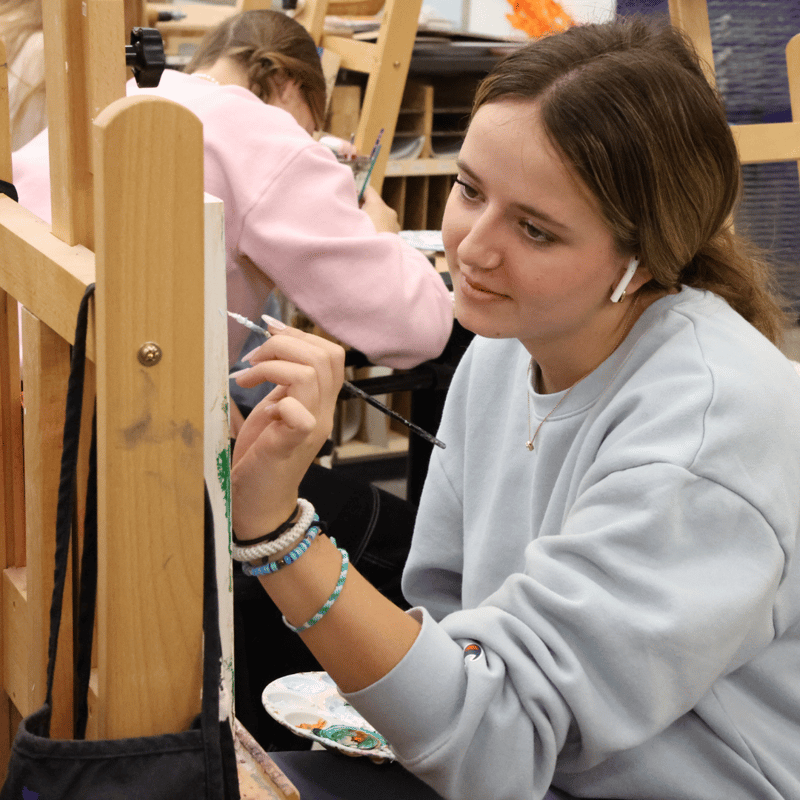3 Steps to Overcome the 'I'm Not Good at Art' Fallacy
LuHi art teachers encounter students who believe they're not good at art. They are determined to shift this perception with encouragement and persistence.
BY Hannah Buchholz
"I'm not good at art."
LuHi art teachers often hear students express this familiar sentiment. So, they are determined to help students overcome this notion!
Mr. Hollenbeck, Head of the Art Department, shares how:
I usually start by asking students how much art they've done because most students base their deduction on very few experiences. I try to get them to see that they should give it a chance. I tell them that maybe they just haven't found something they enjoy - that there is way more to art than drawing.
If they are in Drawing I and say, "I can't draw," I remind them that is what I - the teacher - am here for. I remind them that they don't know how to do calculus before they take a calculus class. That's why you take the class!
Most people see drawing as you have it or you don't. But it takes a lot of practice. If students in my class keep saying, "I'm just not good at art," I say, "All I ask is that you try, and I guarantee you will at least get better!"
Or, if I'm feeling ornery, I ask them, "What is art?" That makes them squirm!
Art is communication, and there is no right or wrong way to do it. It is very individual and personal. There are a lot of very successful artists who "can't draw."
Mrs Saulnier adds, "I always try to ask a question about one of their favorite sports or hobbies and ask if they were great at it the first time they did it. They usually say, 'No, not really; I had to practice before I got good.' I say, 'Same thing with art! We are just here to practice, have fun, and see what kind of art we like to make.'"
So, if the secret to overcoming your fear of "not being good at art" starts with an open mind and practice, here are some practical ways to get started.
How to practice:
1) Pay Attention
Artists take in the world around them before putting pen to paper, hands to clay or brush to canvas. For those dipping their toes into the artistic process, I recommend you take the hard step of slowing down, intentionally paying attention, and noting what you see. The quick, subconscious process of noticing can become transformative. Start by simply by asking questions about what you see. Questions like:
- Do I like that design?
- How are the light and the shadows affecting the colors I see?
- What changes as I get closer or farther from what I observe?
- How would I replicate this? Or change it?
This is a hard step. We love instant gratification. But slowing down - being intentional - about paying attention feels like work. Thankfully, like all skills, it is one you can practice. And for artists, it pays dividends.
2) Copywork
The practice of copywork has opened up a world of possibilities for me design-wise. Copywork starts with paying attention, so it is the second step I recommend (see Step 1). My favorite design teacher, Erik Kennedy, talks a lot about the value of copywork. Here's how he explains it:
"There's a technique for improving one's user interface design skills that is the most efficient way I know of expanding one's visual vocabulary but that I've rarely heard mentioned by digital designers. . . I'm talking about copywork. Copywork is a technique that writers and painters have been using for centuries. It is the process of recreating an existing work as closely as possible in order to improve one's skill… The trick is to pick a design that is better than what you are currently capable of. By copying something outside of your wheelhouse, you will be expanding your skills." Read the full article here.
*Note: Copywork may sound like plagiarism. The point is not for you to take credit for the design or art piece. It is for your own practice and edification.
Copywork doesn't just apply to digital designs. In fact, it used to be a well-known and common practice among many artists.
Years ago, I used to drag one of my roommates to local art museums. She went begrudgingly. It eventually paid off when, during one of my visits, she took me to the MET. (So the real moral of the story here is, if you annoy your friends with culturally rich outings for long enough, they will eventually see the light.)
On these trips, we would stand way too close to the work and verbally talk through what we saw. At the time, I never thought of taking the next step of going home and trying to replicate what I observed. But if I could go back and give advice to my younger self, I would tell myself to do just that!
TLDR about Copywork:
- Notice the work created by designers and artists you like. Ask what is good about this, what misses the mark, and how they did it.
- Grab the tools to start the recreation process and go for it.
- Use trial and error, but don't give up.
- Never claim this work as your original work (credit where credit is due and all). Even if no one ever sees this work, trust you are putting in the time and energy to improve your skill, and this will pay off in spades in your own original works.
3) Try all kinds of mediums.
High school art departments offer a variety of mediums and classes that students with a range of skills can explore. Right now, LuHi offers 11 classes and counting. Try drawing, but if you end up not enjoying it, there is a different option besides throwing the towel in altogether. You could try printmaking. Or ceramics. Or painting. Or photography. Or digital design. (You get it.)
High school is a great time to try new things. The risk is incredibly low if you "fail" - or don't meet your definition of success. If you end up loving it, you might have just found a lifelong love, hobby, or craft.
Our Creator is an artist.
The Creator of the universe cares about color, beauty, design, and order. We see it when we walk outside. But we also feel and naturally understand it because we are created in His image. Creativity is one of the many good gifts He gives us. We know God loves beautiful things because He creates beautiful things!
Throughout Scripture, we can find the importance that God places on art and design. In Exodus, God provides very detailed blueprints of what the Tabernacle should entail. His plans are intricate and beautiful, full of color and detail. But He didn't come down and build it Himself. He equipped Bezalel, Oholiab, and others as they put their artistic skills toward building the Tabernacle.
Centuries later, when the Temple was built, David, Solomon, and even foreigners (2 Chronicles 2:12ff) had a hand in creating the plans and bringing them to reality. Solomon sourced the finest materials for the Temple and its beauty was renowned.
God equips us to be creative, too. Even if our work doesn’t result in a grand scale building project, it can still bring Him glory. Students can explore their artistic talents and abilities to bring glory to God during their time at LuHi.

Fine Arts at LuHi
Our art teachers love their subject and work hard to meet each student at his or her skill level. Nervous or beginner students are met with encouragement and understanding. As their skills grow, students have many ways to show their art in the community and expand their skills.
Some of those annual opportunities include:
- Denver Chalk Art Festival
- Paper Fashion Show
- Douglas County Portfolio Day at the PACE: This event is for juniors. Students present a piece of work or their portfolio to college professors, receive a critique, and then participate in an art show at the PACE.
- National Western Stock Show Youth Art Contest
- Local summer mural projects: So far, students have painted three large murals for the Town of Parker
- Scholastic Art Awards
- Winter Art Market at Clarke Farms: Students sell handmade Christmas ornaments at the market.
- Portrait Contest and Capstone Art Show: Art Academy students paint portraits of live Parker celebrities in four hours. They also show their artwork over the past year while the contest continues.



